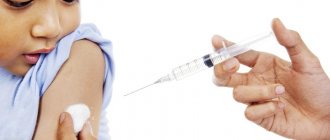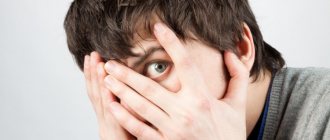Erythrophobia - what is it? This is the fear of blushing. It seems that there is nothing wrong with this. This happens often. This is partly true. But not for erythrophobes. At such moments they experience a whole range of emotions. Moreover, their physical health deteriorates from excitement and anxiety. And in especially severe cases, self-esteem drops and thoughts of suicide appear. Is it really that serious? Is it possible to somehow improve the situation?
What kind of disease is this
Fear of blushing is often confused with blushing syndrome. In contrast, erythrophobia is accompanied by fear.
It is
a reaction of the nervous system to stimuli.
A person can no longer independently control the processes in the body. He is afraid of making a bad impression on his interlocutor and is convinced that a red face repels others. The fear of turning purple in the presence of people is psychological in nature.
There are two types of erythrophobia:
1. Classic . The whole face turns red. 2. Geographical . Certain areas turn purple.
This phobia gives rise to self-doubt, and, as a result, a person experiences neuroses and stress, and tries to avoid crowds of people.
There are other unpleasant consequences of this pathology:
• lack of desire to move forward; • complete withdrawal from interaction with society; • development of depression; • fear of expressing one's opinion; • constant dissatisfaction with oneself.
In rare cases, the patient experiences a feeling of hopelessness and begins to think about suicide.
Causes of erythrophobia
There are many small facial muscles on the face that require increased blood supply. That is why there are so many capillaries here. If not for some physiological features, the skin of the face would be almost constantly red. But in the layer of subcutaneous fatty tissue there is interstitial fluid, due to which the redness becomes less pronounced. But even she cannot completely eliminate hyperemia. Therefore, under stress, excitement, a feeling of shame, embarrassment or, for example, extreme heat, a person blushes.
With erythrophobia the situation looks somewhat different. The nervous system is excited faster than in other people. And for this it is not necessary that a person do something or experience strong emotions. He may blush even when at rest.
People suffering from erythrophobia are in constant tension because they know that they can blush at absolutely any moment. Because of this, they feel fear, which triggers the release of adrenaline. Adrenaline causes even greater stimulation of the nervous system. What happens is what the erythrophobe is so afraid of: ragged red spots appear on his face and body. Over time, such “attacks” become more numerous, therefore, fear intensifies.
It turns out that the face turns red because the person is afraid that the face will turn red. Vicious circle.
Causes
Factors that provoke erythrophobia include:
• excessive shyness in childhood; • taking certain medications; • negative environmental impact; • allergies to food or cosmetics; • long exposure to the sun; • temperature changes; • drinking alcohol, coffee or strong tea; • eating spicy and hot food.
Redness itself is provoked by such health problems as:
• diabetes; • pathologies of the endocrine system, heart and blood vessels; • vascular defects of capillaries; • disorders of the nervous system; • failure of hormone levels; • carcinoid syndrome.
Cholerics, as well as people suffering from hypertension and gastrointestinal diseases, are most susceptible to phobias. Women during menopause, as well as fair-skinned people with blue eyes, are prone to it.
Erythrophobia - fear of blushing
Introduction
Erythrophobia (from the Greek erythros - red), familiar as well as ereutophobia (from the Greek ereuthos - redness, redness), characterizes the fear of blushing, consisting of a series of symptoms and factors genetically embedded in the individual, which actually find energetic strength in emotionality.
Description of the violation
The physical manifestation of this disorder is facial flushing (erythema): a person suddenly turns red due to a sudden rush of blood into dilated superficial vessels (in English “facial blushing”); it is mainly seen in people with white skin.
Closely related are psychological factors, combined with the fear of making mistakes, embarrassment, failure in achieving a goal, feeling not up to par in any situation, dissatisfaction in achieving the desired perfection. Symptoms appear primarily when a person is the center of attention of others, is afraid of blushing, while simultaneously feeling a rapid heartbeat, forced tension in the chest and heat rushing to the face.
Even the slightest doubt or certainty about the impossibility of appearing casual can provoke such a strong discomfort that it does not allow one to overcome the situation with ease, forcing the person to focus on trying to delay the phenomenon, initiating a process in a spiral of obsessive anxiety that can suddenly block thoughts and generate desire in the subject. disappear or run away.
The consequences can be numerous:
- Feelings of insecurity, embarrassment and inferiority in front of others;
- Refusal to overcome new situations that may provoke anxiety;
- Refraining from expressing your own opinion in a group, even if you are sure that it is the most convincing;
- Choosing a profession that does not require social contacts or contacts with colleagues: often these are professions of lower qualifications;
- Career advancement or assignments of higher responsibility are avoided;
- Dissatisfaction with one’s own inability to express and realize one’s professional and mental abilities;
- Progressive development of behavioral phobia, which leads to avoidance of communication and self-isolation (social phobia);
- In less severe cases: a feeling of distress at the enormous waste of mental energy necessary to overcome situations that pose a constant risk of an uncomfortable physical reaction to emotional stress;
- In severe cases: depression, feelings of hopelessness, thoughts of suicide.
Treatment
Relaxation method
There are various physical and psychological techniques aimed at relieving nervous tension and preventing flushing attacks, which are very useful for some subjects and less effective for others. We are talking about the method of self-hypnosis, yoga, auto-training, breathing techniques and progressive muscle relaxation techniques, aimed at increasing self-esteem, confidence in one’s own capabilities and reducing unwanted physical reactions (especially heart palpitations). These techniques can be used collectively or individually, or as an adjunct to psychotherapy.
Psychotherapy
Consultation with a psychologist is almost always recommended. For erythrophobia, cognitive behavioral therapy (CBT) or hypnosis are mainly used. Comparison therapy, the so-called “flooding,” which is quite effective for other types of phobias, is not recommended; on the contrary, it can increase the vulnerability of the subject. Basically, psychotherapy does not eliminate the neurovegetative blushing reflex, ingrained over time, but it can make it easier to coexist with this reaction, simplifying the impact on the quality of life, also increasing the level of self-esteem.
Pharmacotherapy
The following pharmaceutical compounds, often used to counteract physical and/or psychological symptomatology, especially anxiety, are extracted from:
- Beta blockers. Reduce heart rate by limiting the increase in heart rate during stress. In fact, the heartbeat is the main detonator of the chain reaction that leads to uncontrollable emotional stress with accompanying physical manifestations. In the best case, the flushing attack subsides and the concentration of thoughts is maintained.
- Clonidine. It is an alpha blocker that reduces the mobility of the vascular muscles by stabilizing them, which means it tends to limit sudden changes in the caliber of the small vessels of the face. Unfortunately, side effects (low blood pressure with dizziness, dry larynx, etc.) often limit its use.
- Substances that inhibit serotonin capture - SSRI. Substances: citalopram, escitalopram, fluvoxamin, fluoxetin, paroxetin, sertralin. Drugs: Celexa, Cipramil, Fevarin, Fluoxeren, Fontex, Maveral, Paxil, Prozac, Remeron, Seropram, Seroscand, Seroxat, Zoloft. We are talking about a category of antidepressant medications that have also proven to be useful for impulsive and anankastic syndromes, reducing the degree of anxiety from obsessive thoughts. In the case of erythrophobia, these medications can reduce the persistent fear and anxiety of blushing, increasing the limit of stress that can trigger the syndrome.
Anti-anxiety medications such as benzoazepine are not recommended for long-term therapy, primarily due to the risk of drug dependence. Alcohol can also be included in the category of sedatives: without a doubt, it can be effective if consumed only occasionally and in moderate doses, taking into account all the necessary precautions, but naturally cannot be considered the main solution to the problem.
Sympathetic nerve surgery (sympathectomy, sympathetic nerve block)
Already in the 1980s, a positive effect was seen in patients with flushing syndrome (Idiopathic Craniofacial Erythema) who underwent surgery to stop the activity of the first spinal ganglia of the sympathetic nerve for other reasons (Wittmoser). In the 90s, the indication of endoscopic sympathectomy spread not only to treat hyperhidrosis, but also erythrophobia.
Sympathetic nerve surgery is now offered as an alternative treatment for patients with disastrous erythrophobia when the disorder cannot be satisfactorily controlled by nonsurgical measures.
Surgical treatment is effective primarily for the classical form of erythrophobia described above, characterized by sudden redness of the entire face and accompanied by other symptoms of sympathetic nervous system overactivity, primarily rapid heartbeat.
But localized types of facial redness (so-called geographic), indicated by intense redness of the cheeks and/or ears, while the forehead and area around the mouth remain pale, do not respond as well to surgical treatment; in these cases, given the unexpected results (positive result in less than 50% of cases), surgery is not recommended.
An additional type of facial redness typically appears slowly and gradually during sports or physical activity, or during prolonged exposure to heat. With the help of surgery in these cases, only a partial reduction in redness is achieved, since in addition to neurovegetative hyperactivity, other mechanisms come into play that contribute to the dilation of facial vessels. The amount of such reduction depends on other non-sympathetic mechanisms involved (eg hormonal and non-hormonal vasodilators, vasodilatory effects directly related to heat), which varies from individual to individual.
The operation, performed under general anesthesia, involves stopping the activity of the sympathetic nerve (sympathetic trunk) between the T1/T2 nodes located in the upper cavity of the chest near the spinal column. The current preference is to interrupt nerve activity using titanium staples (ESB—endoscopic sympathetic nerve block) rather than an irreversible separation process (ETS—endoscopic torso sympathectomy).
The operation undeniably leads to excellent results regarding redness or phobia, and for many patients it is a release from years of silent and suffocating suffering, often underestimated. According to various studies, the greater success rate of such operations in centers with the most experience in surgical treatment reaches 90-95%. It must be emphasized, however, that in some cases it may be ineffective and in some cases there is a possibility of partial or complete recurrence of the disease, a risk of 5-8% of cases in the first 3 years after surgery. It turns out that in 85% of cases the cure is final, provided that candidates for this treatment are carefully selected by a surgeon who not only has extensive experience, but also has a technique optimized for these purposes and, in particular, a deep knowledge of the problem.
Negative aspects of surgical treatment are characterized by various side effects that may appear immediately or some time after surgery:
- Compensatory sweating. Sweating of the trunk and/or upper legs (reported by most patients), usually in small or moderate amounts, although in a minority of cases it can be unbearable. In our practice, among patients operated on due to erythrophobia, the percentage of reversion, that is, removal of staples due to the undesirable consequences of compensatory hyperhidrosis, is 1%, compared to 12% of patients operated on due to facial hyperhidrosis who request removal of staples due to for increased compensatory sweating. Please note that compensatory sweating never extends to the face and palms; on the contrary, after the operation they appear drier.
- Reducing heart rate and blood pressure, reducing increased activity of the cardiovascular system during emotional motivations. An effect that is observed primarily in those operated on due to erythrophobia and less noticeable in those operated on due to hyperhidrosis. We are almost always talking about a pleasant effect, which significantly affects the feeling of calm that replaces excitement. An excessive decrease in blood pressure and heart rate can provoke a state of weakness and fatigue, which sometimes (in 2% of cases) leads the patient to the decision to remove the braces. This weakness counters the increase in energy and power that most patients experience once they feel freed from oppressive anxiety.
- Tasting sweat. We are talking about emphasizing the feeling of heat and sweating of the face after eating special types of food, especially spicy food. This phenomenon occurs in approximately 1/3 of those undergoing surgery, but rarely in an overtly unpleasant manner.
As a result, we are talking about a safe operation, extremely rarely burdened with complications (mostly of insufficient clinical significance) and with excellent results in terms of controlling the symptom of sudden redness and the state of phobia that occurs from it. Possible and not always foreseeable reactions of the neurovegetative sympathetic system, highly dynamic when adapting to new situations, nevertheless require highly selective and responsible use, limited in refractory cases or not amenable to alternative treatment, in which the harm caused to the patient in situations of a social nature due to erythrophobia is such that it justifies possible side effects. However, it is always necessary to keep in mind that treatment may be ineffective and after time, 10-15% of patients consider themselves dissatisfied with the result. In any case, the author suggests the use of a potentially reversible surgical technique (ESB) instead of a destructive technique (incision, coagulation, removal of nodes).
Dr. Ivo Tarfusser
Symptoms
The main sign of erythrophobia is facial redness, which can be uniform or appear in patches.
Changes in skin color can be seen in the décolleté and neck area. Some patients feel hot.
You can identify symptoms of fear of blushing in a person who is not confident in himself, has difficulty communicating with people, and chooses a job where he does not need to have contact with society. An accurate diagnosis can be made by a psychologist or psychotherapist after the examination and history taking.
Consequences of erythrophobia
If you ignore the manifestations of erythrophobia and do not start treatment, you may encounter a number of extremely unpleasant consequences. And it’s not just panic attacks and fainting:
- self-doubt, inferiority complex;
- apathy, reluctance to make decisions, deal with problems;
- fear of expressing your opinion even if you are sure you are right;
- preference to work where there is no need to frequently contact people;
- dissatisfaction from the realization that it was not possible to realize knowledge, skills, abilities;
- inability to move up the career ladder.
In especially severe cases, social phobia develops, in which a person completely limits communication with other people. This condition is characterized by neuroses, depression, feelings of hopelessness and even suicidal thoughts.
How to get rid
You can eliminate the fear of blushing in front of people with the help of medications, surgery, effects on the psyche and folk methods.
Working with a psychotherapist is considered the most effective. It helps to get rid of the true causes of erythrophobia. A professional specialist can determine the degree of development of the phobia and choose the best way to solve the problem.
With the help of psychocorrection, you can learn to control your emotions and behavior, and calmly react to various situations.
Treatment for erythrophobia includes cognitive behavioral therapy, which helps eliminate bad thoughts and beliefs and changes the type of thinking. This is a very subtle method that requires a person’s conscious desire to be cured of the fear of blushing.
The following drugs are used as medications to combat anxiety and eliminate vasodilation:
1. Beta blockers. 2. Tranquilizers. 3. Alpha blockers.
Often the doctor prescribes a complex of vitamins . Thus, ascorbic acid has vasoconstrictor and anti-edema effects, rutin reduces the fragility of capillaries and strengthens them, vitamin K reduces their permeability. Such products are allowed to be used only after consultation with a specialist. Self-administration of medications may cause undesirable consequences.
Beta blockers
The use of medication also gives good results in the fight against erythrophobia. Antidepressants are popular among medications to help you stay calm in stressful situations. Sometimes, the patient is prescribed beta blockers, which are initially intended to treat problems with the heart and blood pressure. Their essence is to block adrenaline and, naturally, redness of the face. However, the drugs cannot be taken constantly, as they will negatively affect the body. They are used only when an important event is planned.
It is important to understand that conservative methods will not completely eliminate stress redness. As soon as a person stops taking the pills, the result of stimulation of the sympathetic nervous system in moments of embarrassment, excitement or irritation may again appear on the face. Such treatment methods will help to cope with the phobia and reduce the frequency of redness. To achieve the best effect, all experts recommend an integrated approach.
Corr:
That is, you won’t be able to get rid of stress redness through the use of psychology?
Of course no. This sign of the body is not based on psychological problems. It originates at the physiological level of an uncontrolled reaction. Therefore, it will not be possible to get rid of it using this method. I repeat, conservative treatment can only cope with erythrophobia, as well as reduce the incidence of redness.
Operation
Treatment of erythrophobia involves surgery.
During the operation, the operation of the nodes of one of the parts of the autonomic nervous system is affected. It's called sympathectomy .
It is used in case of lack of effect from psychotherapy and medications. For geographic erythrophobia, this method is not recommended.
There are other contraindications:
• serious damage to the heart and blood vessels; • severe sclerosis of cerebral vessels; • some infections.
Surgery is performed under general anesthesia.
It has side effects:
• hypotension; • increased sweating; • reduced reaction to stress.
Reviews about the operation are predominantly positive. Many people have already eliminated unpleasant symptoms. Sympathectomy gives good clinical results and often relieves the patient of problems forever.
Patients note that it is important to choose a professional clinic for the operation and make sure that the doctors are experienced. Sympathectomy is often performed for reasons other than indications. Doctors do not always inform patients about possible conservative treatment methods, as well as what side effects the patient can expect after surgery. It is necessary to ensure that the medical facility is sufficiently equipped with the necessary equipment.
The inexperience of a specialist can lead to a technically incorrect operation. There is a possibility of damage to the accessory nerves, which leads to negative consequences.
Treatment of erythrophobia
Despite the fact that the causes of the disease have not yet been clarified, specialists know how to treat erythrophobia. Several treatment methods have been developed:
Psychotherapy – working with a psychologist
Blushing is an individual bodily reaction to certain feelings that arise in a person - usually these are feelings of shame, and through working with a psychologist, this feeling can be significantly weakened, and over time, completely removed. And then, accordingly, the intensity of redness will be much less and will eventually return to normal. After all, all people blush when they are embarrassed.
Relief of erythrophobia with medications.
Patients are prescribed sedatives and antidepressants. Beta blockers can achieve good results for erythrophobia. Thanks to the medications, the patient manages to remain calm even in stressful situations and not blush. However, taking medications for erythrophobia for a long time is not recommended. Unfortunately, tranquilizers and antidepressants are highly addictive, and beta blockers can cause blood pressure problems. We must not forget that for erythrophobia, treatment with tablets can only be prescribed by a doctor. It is strictly forbidden to self-medicate, take medications uncontrollably, guided by the experience of friends or information from the Internet.
Surgery.
Patients undergo an operation called sympathectomy. The operation takes approximately 30 minutes and is performed under general anesthesia. During the operation, special clamps are inserted into the patient's chest cavity to block the nerve fibers that innervate the blood vessels of the face. At the same time, a person practically stops blushing even in stressful situations. Despite the fact that the operation is considered quite easy and does not require long-term hospitalization and rehabilitation, it is prescribed relatively rarely. As a rule, it is resorted to only if other treatment methods have not brought any results, and the patient does not know how to get rid of erythrophobia.
Try to cope with erythrophobia on your own.
Psychologists recommend not fighting redness, but, on the contrary, trying to cause it with all your might so that it appears in front of people. Try blushing on purpose! If you practice this exercise often enough, the guard will gradually retreat.
If you suffer from erythrophobia, you should not give up your social life and hide from people! Awareness of the problem and willingness to fight it is the first step to recovery!
Treatment at home
Among the non-traditional means, the following methods can be distinguished:
1. Mint decoction. You need to chop 1 tablespoon of mint leaves and pour a glass of boiling water over it. The resulting composition is kept in a water bath for 15 minutes, and then cooled and drunk half a glass in the morning and evening. 2. Hardening. It is necessary to douse yourself with cool water every morning, gradually lowering its temperature. In the evening a contrast shower is shown. 3. Yoga, breathing exercises. These methods will increase self-confidence and reduce unwanted heartbeat.
It is necessary to exclude massage, hot baths and compresses.
Fear of blushing leads to a deterioration in the quality of life and the development of depression. Therefore, it is necessary to treat it completely using modern methods of therapy. It is worth contacting a psychotherapist who will help you find the essence of the problem and relieve unpleasant symptoms.
Treatment
Any phobia is a mental disorder, no matter how insignificant or even cute it may seem.
Therefore, in this case, you should definitely go for a consultation with either a psychotherapist or a psychiatrist. They usually cooperate with each other and, if necessary, will prescribe complex treatment.
A psychologist will help you understand the reasons for your erythrophobia, as well as choose methods that will speed up the recovery process.
The psychiatrist will prescribe antidepressants as accompanying therapy. If, against the backdrop of anxiety, suicidal thoughts arise, there is no desire or strength to simply get out of bed.
Also sedatives to reduce anxiety and open up other senses. After all, anxiety, horror and panic make it difficult to experience tenderness, calmness, joy, and so on.
If you have sleep disturbances, your doctor will prescribe sleeping pills. The body needs to recover at night, otherwise all efforts will go down the drain.
Do not be shy
Many, speaking about this peculiarity of theirs, admit that I am almost always embarrassed, even because of the fleeting glance of a random passerby.
What can we say about situations when you have to speak in public, have an important conversation, look your boss in the eye... Some may blush because of someone else’s mistake, and then the person thinks that his reddened face “screams” about guilt or misconduct. And sometimes, to blush, it’s enough just to remember your natural inclination. But you can learn to live with this feature. And psychologists are unanimous: you just need to allow yourself to blush without feeling shame! — The fear of blushing manifests itself in a public place when a person is not alone, —
says
psychotherapist Ekaterina Averkova.
“
Moreover, this condition can develop from fear itself, that is, without any serious preconditions. A person is afraid to blush and blushes even more: because others will see it and can somehow evaluate and interpret it. Anxiety increases, and over time the situation can worsen: people fall into a stupor when an interlocutor approaches them, this can lead to anxiety disorders, fear of visiting public places, speaking, and depression.
Where does erythrophobia come from? As psychotherapists like to say, everything comes from childhood.
“Most likely, the child didn’t even notice that he was blushing,”
says Ekaterina Averkova.
“We all blush, but not everyone attaches such great importance to it.” But if someone told the child about this, laughed and gave some kind of social assessment, then next time he may be afraid of repeating the situation. The reaction is consolidated, this will be accompanied by an excessive feeling of shame, the fear of being a laughing stock, hurt or weak.
Pale look
But I returned from the meeting with the Moscow doctor discouraged: for half an hour the doctor... tried to dissuade me from the operation. I was frightened by the side effects. These warnings probably stopped someone, but not the girl in love! The very next morning I woke up with a firmly made decision and went to the surgeon again... The operation lasted half an hour, I felt the results immediately. As the classics wrote: “Her cheeks remained as cold as ice...” A day later I was discharged from the clinic. The puncture sites only hurt a little. The doctor warned: try not to gain weight, don’t go to the bathhouse, don’t sunbathe in the solarium, refrain from traveling to resorts with a hot climate... Germany is not the warmest country - I flew to see Karl a week later. Probably no one has ever been as happy about his pale appearance as I am!
I also made a vow to myself. When I have a child, I will try to send him to a school where teachers will worry about how not to hurt the child with a careless word, not to cause him spiritual wound.
V.K.:
How is the operation performed? The surgeon only needs half a centimeter punctures to get close to the sympathetic ganglia. The surgical technique would be used more often, but this method of treating erythrophobia has side effects. The nerve that surgeons compress is responsible not only for the blood vessels on the face, but also controls sweating. Therefore, in some cases, a person’s chest, back, stomach, and sometimes hips and buttocks begin to sweat a lot. This problem is called compensatory hyperhidrosis. Nina was lucky: she did not experience this complication.










